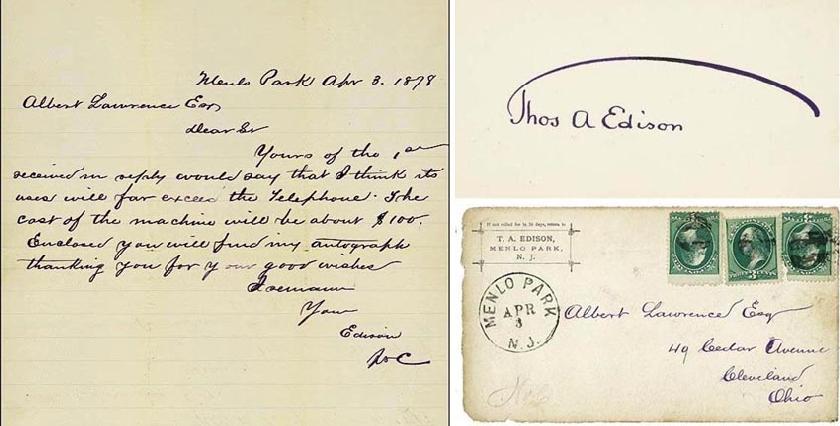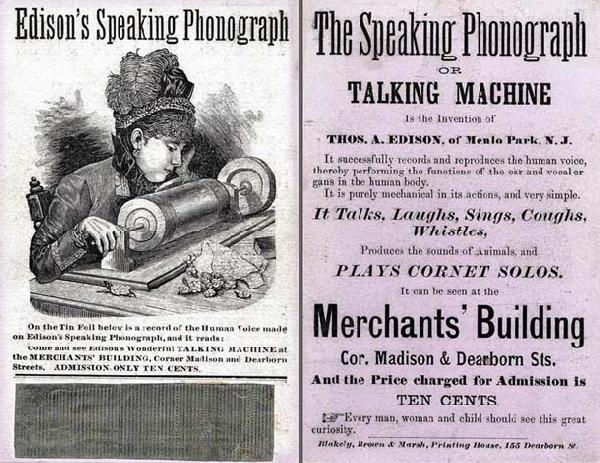
Although the tinfoil phonograph attracted a great deal of attention when it was first shown to the public at the end of 1877, very few related materials have survived. Paper items such as trade cards and handbills offer unique insight into the marketing the phonograph in its infancy, however, these "ephemeral" items were never intended to last and are very hard to find today.

Prior to the invention of the phonograph in December 1877, Thomas Edison was
virtually unknown among the general public. It was the tinfoil phonograph that made
Edison an instant celebrity. This was a new and heady experience for the young (30
years old) inventor. It is perhaps no coincidence that Edison started signing his
name in a more flamboyant manner only after he became famous that December, adding
an "umbrella" paraph to what had been a very ordinary signature. He retained
the umbrella motif for the rest of his life, and even trademarked his autograph in
the 1890s.
This letter to an admirer was written on April 3, 1878, one week
before Edison would be dubbed "THE WIZARD OF MENLO PARK" by the New York
Graphic newspaper, and two weeks before his presentation of the phonograph in Washington,
DC (at which time the famous Brady pictures illustrated below were taken). Signed
secretarily by Edison's bookkeeper William Carman, the letter predicts that the phonograph's
"uses will far exceed the telephone" and set a price of "about $100"
for the machine. This was one of the earliest requests Edison ever received for his
autograph. Soon thereafter the trickle became a flood, which lasted for the rest
of his life. (The first reference to autograph seekers in Edison's personal correspondence
appears on April 16th when he wrote to his associate Uriah Painter "Autographs
& Begging letters commencing to come in.")
Amazingly, the original
request sent to Edison by his Ohio fan still exists, in the archives of the Edison
National Historic Site (see copy below). Edison jotted a note on the letter instructing
Carman to "send him a little of the foil." Alas that this very early piece
of recorded tinfoil is no longer in the original envelope with Edison's letter and
autograph!


On April 18, 1878, Edison took his second model of tinfoil phonograph to Washington D.C. to present to the Academy of Sciences. On the following day he went to the studios of famed Civil War photographer Mathew Brady to have his portrait taken. These pictures were then sold to the public in either vertical "Cabinet Card" as seen above (about 4-1/2" by 6-1/2" or horizontal "Carte de Visite" format (about 4" by 2-1/2") shown below. Edison agreed not to pose for any other photographs for a period of time after the sitting so that Brady could have a monopoly on sales of Edison's image.

The "Carte de Visite" photograph below was cut down and glued into
a fine gilt-edged album along with Edison's autograph. The penciled note was written
by the original collector, identifying where and when the autograph was obtained:
"April 18, 1878, while Edison was in Wash. to demonstrate his tin foil phonograph
to Pres. Hayes at the White House & before the National Academies of Science
meeting. Photo by Brady.” The collector later mounted the original photograph to
the page. (On the reverse of this album page is a Brady photograph and separate autograph
of Kate Field, noted journalist, author, and feminist.)
It is not generally
known that there were approximately 15 different versions of this famous Edison photograph
taken during his visit to Brady studios. Two different backgrounds were used -- plain,
as seen in the first two photographs above, or painted backdrop as seen on the autograph
album page below. Even among photographs with the same background there are subtle
but obvious differences among the various pictures as can be noted by comparing the
folds in his jacket in the different images.


This check was issued by the Edison Speaking Phonograph Co. in payment of monthly royalties owed to Edison for his share of phonograph exhibition income. It was issued and signed June 1, 1878 by Charles Cheever, a major investor in the Speaking Phonograph Company and the company's treasurer at the time. On the back, Edison has endorsed the check over to his assistant, Charles Batchelor, who was Edison's right-hand man in the Menlo Park lab. Most of the improvements made to the tinfoil phonograph in 1878 were Batchelor's inventions. While Edison took credit for his employees' inventive work, he was generous in compensating key people like Batchelor.

This trade card was used to promote phonograph exhibitions in Chicago in 1878. (Such "trade cards" were a very popular form of advertising in that era.) The exhibitor found a clever way to use old sheets of recorded foil left over from earlier demonstrations -- he cut up them up and glued a small 3" by 1" scrap to the front of the card. The recorded indentations are intact and easily seen. Though it is obviously unplayable, it remains one of the very few surviving pieces of recorded tinfoil in existence.

Another early trade card advertises phonograph exhibitions starting June 11, 1878, in an unnamed city. This is smaller than the previous card, measuring only 2-1/2" by 4".